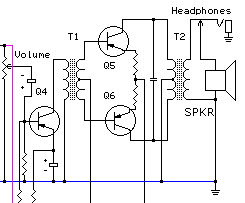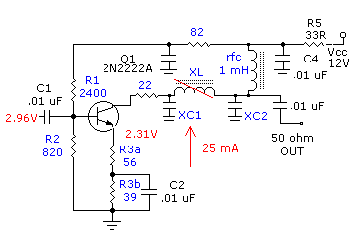How important is impedance matching?
It can be shown mathematically that any source of power e.g. a receiver antenna, an audio amplifier or an amateur radio transmitter will deliver its maximum possible power output when the impedance of the subsequent load is equal to the internal impedance of that source. This is achieved through impedance matching.
Unfortunately in this situation the efficiency can only be 50% because half the power is consumed in the source.
Examples of Impedance Matching
Our first example is one of an old type transistor radio where in the audio stages the output speaker was a typical 8 ohms. Such stages are impedance matched by audio transformers as depicted in figure 1 below.

Fig 1 - schematic of impedance matching of transistor audio stages
Typical values for these stages might be for our transformers, T1 5K to 2K CT (centre tapped) and for T2 250 ohm CT to VC (Voice coil) of say 8 ohms. The essential point here is that to perform satisfactorily each stage must be impedance matched to both source and load.
The next example might well be the input of a radio receiver connected to a 50 ohm antenna. Here we would use a tuned circuit amplifier. One illustration from that tutorial might be in the figure below.

Figure 2 - a schematic using a low pass filter for impedance matching
Link to this page
NEW! - How to link directly to this page
Want to create a page link to me from your site? It couldn't be easier. No HTML knowledge required; even the technophobes can do it. All you need to do is copy and paste, the following code. All links are greatly appreciated; I sincerely thank you for your support.
Copy and paste the following code for a text link:
<a href="http://www.electronics-tutorials.com/basics/impedance-matching.htm" target="_top">visit VK2TIP's Impedance Matching Tutorial Page</a>
and it should appear like this:
visit VK2TIP's Impedance Matching Tutorial Page

This site is hosted at WebWizards.Net for better value.
CARE TO BE A PRACTICAL SUPPORTER OF THIS SITE?
As you would imagine maintaining this site costs me considerable sums of money in many, many ways. If you believe this site is a valuable and FREE educational resource and, YOU want to keep it that way, then here's how YOU can demonstrate your very practical support for this site..
Thanks to these fine folks making voluntary donations, ensuring this site and our Newsletter remains FREE. Could YOU be listed here for your small contribution in return for your FREE education?. Our grateful thanks.


Please send me your valuable comments and suggestions! Tell your friends, tell a news group, tell your favourite magazine, heck tell the world!
Absolutely essential to keeping abreast of new and updated electronics tutorials is our comments or subscribe to our highly regarded FREE monthly newsletter form. Unsubscribe any time you like. You can view immediate past issues here to see if it is to your liking.
Related topics on impedance matching
audio transformers
low pass filters
impedance
toroid cores
tuned circuit amplifiers

YOU ARE HERE: HOME > BASICS > IMPEDANCE MATCHING
the author Ian C. Purdie, VK2TIP of www.electronics-tutorials.com asserts the moral right to
be identified as the author of this web site and all contents herein. Copyright © 2000, all rights reserved. See copying and links.
These electronic tutorials are provided for individual private use and the author assumes no liability whatsoever for the application, use, misuse, of any of these projects or electronics tutorials that may result in the direct or indirect damage or loss that comes from these projects or tutorials. All materials are provided for free private and public use.
Commercial use prohibited without prior written permission from www.electronics-tutorials.com.
Copyright © 2000, all rights reserved. URL - www.electronics-tutorials.com/basics/impedance-matching.htm
Updated 27th October, 2000
webmaster@electronics-tutorials.com


